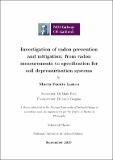| dc.contributor.advisor | Foley, Mark | |
| dc.contributor.author | Fuente Lastra, Marta | |
| dc.date.accessioned | 2020-01-27T16:19:00Z | |
| dc.date.available | 2020-01-27T16:19:00Z | |
| dc.date.issued | 2020-01-27 | |
| dc.identifier.uri | http://hdl.handle.net/10379/15742 | |
| dc.description.abstract | Reduction of indoor radon concentration in buildings is considered to be an important public health issue, since radon was recognised as the leading cause of lung cancer after tobacco smoking by the World Health Organisation. The study of radon protective measures for buildings has become more important recently, in accordance with the 2013/59/EURATOM BSS Directive, mandatory since February 2018 within the member states of the European Union. This thesis work was conceived within the National Radon Control Strategy for Ireland to investigate the effectiveness of radon prevention and mitigation measures, with the main aim to determine specifications for the optimum performance of soil depressurisation systems. For that purpose, a case study in an experimental house was conducted over a year to test the ability of active and passive soil depressurisation systems, focused on pressure field extension and the radon reductions achieved. Complementary laboratory-based experiments were conducted to examine the properties of granular fill materials used in the aggregate layer under the slab, which affects soil depressurisation. Main findings from the work were the permeability characterisation of various standard granular fill materials within the European context, the distribution of the pressure
induced under the slab and its behaviour as a function of the extraction airflow. Additionally, radon reductions in relation to the soil depressurisation system features were quantified. Further, in order to assess the performance of instrumentation for radon in-air measurements, a benchmark study of radon monitors in a purpose-built radon chamber was carried out. The key finding from this research was that, although different radon monitors provide an accurate measurement, response time to fluctuation in the radon concentration can vary and, therefore, selection of the appropriate detector should be specific to the application. This work gives an insight into the understanding of the operation of soil depressurisation systems and the resulting findings contribute to specifications for optimum radon protection by soil depressurisation within an European context, which can potentially inform revision of the building regulations. | en_IE |
| dc.publisher | NUI Galway | |
| dc.rights | Attribution-NonCommercial-NoDerivs 3.0 Ireland | |
| dc.rights.uri | https://creativecommons.org/licenses/by-nc-nd/3.0/ie/ | |
| dc.subject | Radon | en_IE |
| dc.subject | Radon mitigation | en_IE |
| dc.subject | Soil depressurisation system | en_IE |
| dc.subject | Radon monitor | en_IE |
| dc.subject | Granular fill material | en_IE |
| dc.subject | Pressure field extension | en_IE |
| dc.subject | Permeability | en_IE |
| dc.subject | Response time | en_IE |
| dc.subject | Physics | en_IE |
| dc.subject | Science | en_IE |
| dc.title | Investigation of radon prevention and mitigation: from radon measurements to specification for soil depressurisation systems | en_IE |
| dc.type | Thesis | en |
| dc.contributor.funder | Environmental Protection Agency | en_IE |
| dc.local.note | Radon is the leading cause of lung cancer after tobacco smoking according to the World Health Organisation. Thus, reducing indoor radon concentration is considered an important public health issue. Soil depressurisation technique for radon reduction in buildings was investigated to improve the effectiveness of radon prevention and mitigation measures. | en_IE |
| dc.local.final | Yes | en_IE |
| nui.item.downloads | 340 | |


